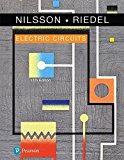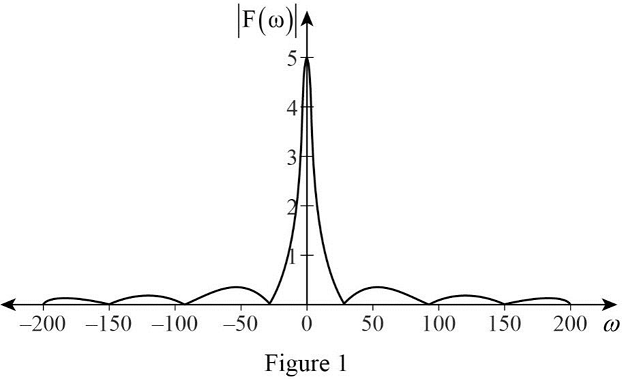
Concept explainers
(a)
Calculate the Fourier transform of the function shown in the given Figure.
(a)
Answer to Problem 1P
The Fourier transform for the function given in Figure is
Explanation of Solution
Given data:
Refer to Figure given in the textbook.
Formula used:
Write the general expression for the function
Write the general expression for definite integral
Calculation:
In the given Figure, the function
The end points of the function
The slope of the straight line is calculated as follows,
Substitute
Therefore, for the given Figure, the function
Applying equation (3) in equation (2) as follows,
Consider,
Write the general expression for integration by parts method as follows,
By applying integration by parts to equation (5),
Applying equation (6) in equation (5) as follows,
Consider,
Consider,
Substitute
Substitute equation (9) in equation (7) as follows,
The above equation as follows,
Substitute equation (10) in equation (4), and applying the limits as follows,
Conclusion:
Thus, the Fourier transform for the function given in Figure is
(b)
Calculate
(b)
Answer to Problem 1P
The function
Explanation of Solution
Given data:
Refer to Part (a).
Formula used:
Write the general expression for L’Hospital’s rule as follows,
Calculation:
Applying equation (12) to equation (11) when
The above equation becomes,
Conclusion:
Thus, the function
(c)
Plot
(c)
Answer to Problem 1P
The sketch for
Explanation of Solution
Given data:
Refer to Part (a),
Calculation:
Appling
Create a table as shown in below Table 1.
Table 1
| Angular Frequency | Function |
| –200 | 0.0785 |
| –190 | 0.1041 |
| –180 | 0.1063 |
| –170 | 0.0819 |
| –160 | 0.0336 |
| –150 | 0.0295 |
| –140 | 0.0943 |
| –130 | 0.1452 |
| –120 | 0.1678 |
| –110 | 0.1522 |
| –100 | 0.0951 |
| –90 | 0.0014 |
| –80 | 0.1161 |
| –70 | 0.2389 |
| –60 | 0.3457 |
| –50 | 0.4162 |
| –40 | 0.4354 |
| –30 | 0.3962 |
| –35 | 0.3012 |
| –15 | 0.1625 |
| 0 | 5.0000 (Original value is infinity, though for the instance consider one finite value as 5) |
| 10 | 0.1625 |
| 20 | 0.3012 |
| 30 | 0.3962 |
| 40 | 0.4354 |
| 50 | 0.4162 |
| 60 | 0.3457 |
| 70 | 0.2389 |
| 80 | 0.1161 |
| 90 | 0.0014 |
| 100 | 0.0951 |
| 110 | 0.1522 |
| 120 | 0.1678 |
| 130 | 0.1452 |
| 140 | 0.0943 |
| 150 | 0.0295 |
| 160 | 0.0336 |
| 170 | 0.0819 |
| 180 | 0.1063 |
| 190 | 0.1041 |
| 200 | 0.0785 |
Sketch the plot for various values of function

Conclusion:
Thus, the sketch for
Want to see more full solutions like this?
Chapter 17 Solutions
Electric Circuits Plus Mastering Engineering with Pearson eText 2.0 - Access Card Package (11th Edition) (What's New in Engineering)
- solve and show workarrow_forward2) (15pts) In a PAM baseband digital communication system, an M-ary system has a channel bandwidth of 2 KHz. The channel introduces 10dB of losses and AWGN noise with a power spectral density of 1*10-6 W/Hz. The application requires a bit rate of 4.8 Kbps and BER of less than 10^-6. Estimate the require transmit power.arrow_forwardi need helppp pleasearrow_forward
- 1) (2pts) If you know you have a bad clock (lots of jitter) and you are not bandwidth constrained, you should: (Circle the correct answer) a) Set the roll off factor to zero b) Set the roll off factor to ½ c) Set the roll off factor to one 2) (2pts) Short answer: Why do we use M-ary modulation? 3) (4 pts) Short answer: The application engineer comes to your desk and says that the error rate is too high and must be reduced for the application to function correctly. The system is battery operated. What do you tell them is the trade- off?arrow_forwardi need helppp pleasearrow_forward5) (20 pts) You are testing a system that has pulse shape shown below for Logic 1 and Logic 0. You are connecting the transmitter to an oscilloscope which is set up to display the resulting eye-diagram of the system. Sketch what you would expect to see on the oscilloscope for an ideal system (an ideal system is noiseless and jitter free) Logic 1 3 volts Time 0 Ть Logic 0 0 Ть Time -2 voltsarrow_forward
- 4. (20 pts) You are given a channel with the following impulse response. Determine the set of equations that will be used to determine the coefficients of a Zero-Forcing Linear Equalizer. DO NOT SOLVE FOR THE COEFFICIENTS. Just show the set of equation that would be used to solved the coefficients. 0 m≤-31 -0.33 m = -2 .25 m = -1 h(mb) = 1 m = 0 -0.45 m = 1 0.5 m = 2 0 m≥3arrow_forwardI need help understanding part B. See attached photo.arrow_forwardi need helppp pleasearrow_forward
- 3) (30pts) An application requires a bit rate of 18.2 Kbps and an error rate of less than 104. The channel has a noise power spectral density of 10-8 W/Hz. The channel attenuates the power in the signal by 5 dB. The system uses binary PAM baseband digital communication system with the minimum required bandwidth and a roll-off factor of 0.319. a) (10 pts) What is the estimated minimum required signal power (Pt) at the transmitter?arrow_forwardi need helppp pleasearrow_forwardi need helppp pleasearrow_forward
 Introductory Circuit Analysis (13th Edition)Electrical EngineeringISBN:9780133923605Author:Robert L. BoylestadPublisher:PEARSON
Introductory Circuit Analysis (13th Edition)Electrical EngineeringISBN:9780133923605Author:Robert L. BoylestadPublisher:PEARSON Delmar's Standard Textbook Of ElectricityElectrical EngineeringISBN:9781337900348Author:Stephen L. HermanPublisher:Cengage Learning
Delmar's Standard Textbook Of ElectricityElectrical EngineeringISBN:9781337900348Author:Stephen L. HermanPublisher:Cengage Learning Programmable Logic ControllersElectrical EngineeringISBN:9780073373843Author:Frank D. PetruzellaPublisher:McGraw-Hill Education
Programmable Logic ControllersElectrical EngineeringISBN:9780073373843Author:Frank D. PetruzellaPublisher:McGraw-Hill Education Fundamentals of Electric CircuitsElectrical EngineeringISBN:9780078028229Author:Charles K Alexander, Matthew SadikuPublisher:McGraw-Hill Education
Fundamentals of Electric CircuitsElectrical EngineeringISBN:9780078028229Author:Charles K Alexander, Matthew SadikuPublisher:McGraw-Hill Education Electric Circuits. (11th Edition)Electrical EngineeringISBN:9780134746968Author:James W. Nilsson, Susan RiedelPublisher:PEARSON
Electric Circuits. (11th Edition)Electrical EngineeringISBN:9780134746968Author:James W. Nilsson, Susan RiedelPublisher:PEARSON Engineering ElectromagneticsElectrical EngineeringISBN:9780078028151Author:Hayt, William H. (william Hart), Jr, BUCK, John A.Publisher:Mcgraw-hill Education,
Engineering ElectromagneticsElectrical EngineeringISBN:9780078028151Author:Hayt, William H. (william Hart), Jr, BUCK, John A.Publisher:Mcgraw-hill Education,





